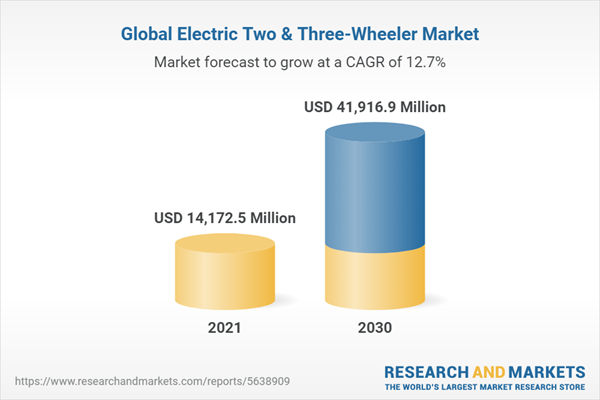The global electric two & three-wheeler market held a market value of USD 14,172.5 Million in 2021 and is estimated to reach USD 41,916.9 Million by the year 2030. The market is anticipated to register a CAGR of 12.7% during the forecast period. The market held a volume of 21,231,575.9 (thousand units) in 2021.
The rising awareness related to the energy-efficient modes of transport is directly boosting the growth rate of this industry. Companies are involved in the usage and production of environmentally safe raw materials and components to target a more extensive customer base. In February 2021, Electric vehicle battery startup Italvolt (Italy), announced an investment of 4 Billion euros (USD 4.9 Billion) to build a factory in Italy to meet growing demand from Europe’s automotive industry.
Further to that, the increase in the number of subsidies, tax rebates offered by the government officials around the world for the purchase of electric vehicles is propelling the growth rate. For instance, the government officials in the state of Maharashtra, India declared an EV policy in 2021. Such a policy offers incentives of USD 65.50 per kilowatt-hour of battery capacity to all types of electric vehicles buyers.
On the other hand, owing to the smaller number of EV charging ports, the end user preference for electric vehicles remain questionable in many economies.
Growth Influencers:
Growing demand for energy-efficient commuting
The rising support from public as well as private organizations in support of energy efficient means of transport is propelling the growth of the market. The rising research as well as consumer awareness. An inclination of electric two and three wheelers in many countries can aid in the reduction of several issues of economy, power, environment. The consumers are preferring routes that decrease the power consumption and aid the environment and energy efficient models.
Decreasing Price of Batteries
Regions such as European Union is pushing to boost its battery production on the continent to compete with China, currently home to around 80% of the world’s lithium-ion cell manufacturing capacity, with the aim of becoming self-sufficient by 2025. Such strategies direct towards the growing need for safer and efficient components for electric vehicle production, thus creating lucrative opportunities in the near future.
Moreover, the pricing fluctuations and decrease has boosted the market growth. For instance, the price of lithium-ion battery cells declined by 97% in the last three decades. A battery with a capacity of one kilowatt-hour that cost USD 7500 in 1991 costed around USD 181 in 2018.
Segments Overview:
The global electric two & three-wheeler market is segmented into vehicle type, usage, and end user.
By Vehicle Type
- 2-Wheeler
- Three-wheeler
The three-wheeler segment is projected to hold the highest CAGR of 16% owing to the increased sales and awareness of this vehicle type in the developing regions.
By Usage
- Personal/ Private
- Commercial
- Passenger Carrier
- Goods Carrier
The personal/ private segment is anticipated to hold an opportunity of more than USD 13,000 Million during 2022 to 2030.
By End User
- Individuals (B2C)
- Businesses (B2B)
- Logistics Companies
- Transport (Fleet Operators)
- Retail & E-commerce
- Utilities
- Hospitality
- Others
The businesses segment is expected to grow highest with a rate of 13% over the forecast period.
Regional Overview
By region, the global Electric two & three-wheeler market is divided into Europe, North America, Asia Pacific, Middle East & Africa, and South America.
The Asia Pacific market held the largest market share of more than 95% in 2021. The European region is predicted to grow at a steady rate owing to the rising product launches. The North American industry is growing due to the increasing demand for cutting-edge advancements in electric two & three-wheelers. Moreover, the Latin American market for electric two and three wheelers is likely to grow highest with a CAGR of 8.8% over the forecast period.
Competitive Landscape
The chief players operating in the global Electric two & three-wheeler market constitute Scooters India Limited, Atul Auto Limited, Chongqing Zongshen Tricycle Manufacture Co. Ltd., Bajaj Auto Ltd., Terra Motors Corporation, Dilli Electric, Force Motors, Mahindra & Mahindra Ltd, J.S. Auto Pvt Ltd, Lohia, Kinetic Green Energy & Power Solutions Ltd, Piaggio & C.SpA, Mini Metro, Saera Electric, and TVS Motor Company.
Such market players are investing in collaborations, expansions, mergers, acquisitions, and expansions to create a competitive edge in the market. For instance, in December 2021, Bajaj Auto started its new electric vehicle manufacturing unit for India as well as exports at Akurdi, Pune, India. The vehicles are expected to roll out by June 2022. The company invested USD 40 Million in this facility and it has a production capacity of 500,000 electric vehicles per annum.
The global electric two & three-wheeler market report provides insights on the below pointers:
- Market Penetration: Provides comprehensive information on the market offered by the prominent players
- Market Development: The report offers detailed information about lucrative emerging markets and analyzes penetration across mature segments of the markets
- Market Diversification: Provides in-depth information about untapped geographies, recent developments, and investments
- Competitive Landscape Assessment: Mergers & acquisitions, certifications, product launches in the global electric two & three-wheeler market have been provided in this research report. In addition, the report also emphasizes the SWOT analysis of the leading players.
- Product Development & Innovation: The report provides intelligent insights on future technologies, R&D activities, and breakthrough product developments
- Pricing Analysis: Pricing analysis of various metals and other components used in the manufacturing
- Manufacturing Cost Analysis: Cost-share of various components in electric two & three-wheeler, cost analysis of electric two & three-wheeler
- Industry outlook
- Top Companies sales comparison
The global electric two & three-wheeler market report answers questions such as:
- What is the market size and forecast of the global electric two & three-wheeler market?
- What are the inhibiting factors and impact of COVID-19 on the Global electric two & three-wheeler Market during the assessment period?
- Which are the products/segments/applications/areas to invest in over the assessment period in the global electric two & three-wheeler market?
- What is the competitive strategic window for opportunities in the global electric two & three-wheeler market?
- What are the technology trends and regulatory frameworks in the global electric two & three-wheeler market?
- What is the market share of the leading players in the global electric two & three-wheeler market?
- What modes and strategic moves are considered favorable for entering the global electric two & three-wheeler market?
Table of Contents
Companies Mentioned (Partial List)
A selection of companies mentioned in this report includes, but is not limited to:
- Scooters India Limited
- Atul Auto Limited
- Chongqing Zongshen Tricycle Manufacture Co. Ltd.
- Bajaj Auto Ltd.
- Terra Motors Corporation
- Dilli Electric
- Force Motors
- Mahindra & Mahindra Ltd
- J.S. Auto Pvt Ltd
- Lohia
- Kinetic Green Energy & Power Solutions Ltd
- Piaggio & C.SpA
- Mini Metro
- Saera Electric
- TVS Motor Company
Table Information
| Report Attribute | Details |
|---|---|
| No. of Pages | 372 |
| Published | July 2022 |
| Forecast Period | 2021 - 2030 |
| Estimated Market Value ( USD | $ 14172.5 Million |
| Forecasted Market Value ( USD | $ 41916.9 Million |
| Compound Annual Growth Rate | 12.7% |
| Regions Covered | Global |









